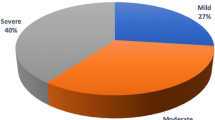Abstract
Background
“One-stop” outpatient hysteroscopy clinics have become well established for the investigation and treatment of women with abnormal uterine bleeding. However, the advantages of these clinics may be offset by patient factors such as anxiety, pain, and dissatisfaction. This study aimed to establish patients’ views and experiences of outpatient service delivery in the context of a one-stop diagnostic and therapeutic hysteroscopy clinic, to determine the amount of anxiety experienced by these women and compare this with other settings, and to determine any predictors for patient preferences.
Methods
The 20-item State–Trait Anxiety Inventory was given to 240 women attending a one-stop hysteroscopy clinic: to 73 consecutive women before their appointment in a general gynecology clinic and to 36 consecutive women attending a chronic pelvic pain clinic. The results were compared with published data for the normal female population, for women awaiting major surgery, and for women awaiting a colposcopy clinic appointment. In addition, a questionnaire designed to ascertain patients’ views and experiences was used. Logistic regression analysis was used to delineate the predictive values of diagnostic or therapeutic hysteroscopy, and to determine their effect on the preference of patients to have the procedure performed under general anesthesia in the future.
Results
Women attending the hysteroscopy clinic in this study reported significantly higher levels of anxiety than those attending the general gynecology clinic (median, 45 vs 39; p = 0.004), but the levels of anxiety were comparable with those of women attending the chronic pelvic pain clinic (median, 45 vs 46; p = 0.8). As compared with the data from the normal female population (mean, 35.7) and those reported for women awaiting major surgery (mean, 41.2), the levels of anxiety experienced before outpatient hysteroscopy clinic treatment were found to be higher (mean, 45.7). Only women awaiting colposcopy (6-item mean score, 51.1 ± 13.3) experienced significantly higher anxiety scores than the women awaiting outpatient hysteroscopy (6-item mean score, 47.3 ± 13.9; p = 0.002). Despite their anxiety, most women are satisfied with the outpatient hysteroscopy “see and treat” service. High levels of anxiety, particularly concerning pain but not operative intervention, were significant predictors of patients desiring a future procedure to be performed under general anesthesia.
Conclusions
Outpatient hysteroscopy is associated with significant anxiety, which increases the likelihood of intolerance for the outpatient procedure. However, among those undergoing operative therapeutic procedures, dissatisfaction was not associated with the outpatient setting.


Similar content being viewed by others
References
RL Bekkers DM der Particlevan FM Klaver et al. (2002) ArticleTitleVariables influencing anxiety of patients with abnormal cervical smears referred for colposcopy. J Psychosom Obstet Gynaecol 23 257–261 Occurrence Handle1:STN:280:DC%2BD3s%2FhsFWktg%3D%3D Occurrence Handle12520863
TJ Clark J Godwin KS Khan et al. (2002) ArticleTitleAmbulatory endoscopic treatment of symptomatic benign endometrial polyps: a feasibility study. Gynaecol Endosc 11 91–97 Occurrence Handle10.1046/j.1365-2508.2002.00485.x
TJ Clark JK Gupta (2002) ArticleTitleOutpatient hysteroscopy. Obstet Gynaecol 4 217–221
TJ Clark D Mahajan P Sunder et al. (2002) ArticleTitleHysteroscopic treatment of symptomatic submucous fibroids using a bipolar intrauterine system: a feasibility study. Ear J Obstetrician Gynecologist Reprod Biol 100 237–242 Occurrence Handle10.1016/S0301-2115(01)00485-7
Diagnostic and Treatment Centres (2001) A new dimension in healthcare. Department of Health. The NHS Plan. Investment and Reform for NHS Hospitals. 2001. Accessed at http://www.doh.gov.uk/investmentreform/investment.pdf
T Freeman-Wang P Walker Linehan-J et al. (2001) ArticleTitleAnxiety levels in women attending colposcopy clinics for treatment for cervical intraepithelial neoplasia: a randomised trial of written and video information. BJOG 108 482–484 Occurrence Handle10.1016/S0306-5456(00)00121-2 Occurrence Handle1:STN:280:DC%2BD3M3nsFCjtg%3D%3D Occurrence Handle11368133
RE Howells PD Dunn T Isasi et al. (1999) ArticleTitleIs the provision of information leaflets before colposcopy beneficial? A prospective randomised study. Br J Obstet Gynaecol 106 528–534 Occurrence Handle1:STN:280:DyaK1MzltlKrsg%3D%3D Occurrence Handle10426608
KS Khan PF Chien LS Dwarakanath (1999) ArticleTitleLogistic regression models in obstetrics and gynecology literature. Obstet Gynecol 93 1014–1020 Occurrence Handle10.1016/S0029-7844(98)00537-7 Occurrence Handle1:STN:280:DyaK1M3ovFSiuw%3D%3D Occurrence Handle10362173
TM Marteau H Bekker (1992) ArticleTitleThe development of a six-item short form of the state scale of the Spielberger State–Trait Anxiety Inventory (STAI). Br J Clin Psychol 31 301–306 Occurrence Handle1393159
SD Mathias M Kuppermann RF Liberman et al. (1996) ArticleTitleChronic pelvic pain: prevalence, health-related quality of life, and economic correlates. Obstet Gynecol 87 321–327 Occurrence Handle10.1016/0029-7844(95)00458-0 Occurrence Handle1:STN:280:BymC2snkvVE%3D Occurrence Handle8598948
GR Norman DL Streiner (1994) Screwballs, oddballs, and other vagaries of science: locating outliers, handling missing data and transformations. GR Norman DL Streiner (Eds) Biostatistics: the bare essentials. Mosby St Louis 202–210
CD Spielberger (1983) Manual for the State–Trait Anxiety Inventory. STAI (Form Y). Psychologists Press Palo Alto, California
DJ Sulkes IU Scott HW Flynn SuffixJr et al. (2002) ArticleTitleEvaluating outpatient versus inpatient costs in endophthalmitis management. Retina 22 747–751 Occurrence Handle10.1097/00006982-200212000-00010 Occurrence Handle12476101
KT Zondervan PL Yudkin MP Vessey et al. (2001) ArticleTitleChronic pelvic pain in the cornmunity: symptoms, investigations, and diagnoses. Am J Obstet Gynecol 184 1149–1155 Occurrence Handle10.1067/mob.2001.112904 Occurrence Handle1:STN:280:DC%2BD3Mzls1SmtA%3D%3D Occurrence Handle11349181
Author information
Authors and Affiliations
Corresponding author
Rights and permissions
About this article
Cite this article
Gupta, J.K., Clark, T.J., More, S. et al. Patient anxiety and experiences associated with an outpatient “one-stop” “see and treat” hysteroscopy clinic. Surg Endosc 18, 1099–1104 (2004). https://doi.org/10.1007/s00464-003-9144-3
Received:
Accepted:
Published:
Issue Date:
DOI: https://doi.org/10.1007/s00464-003-9144-3




